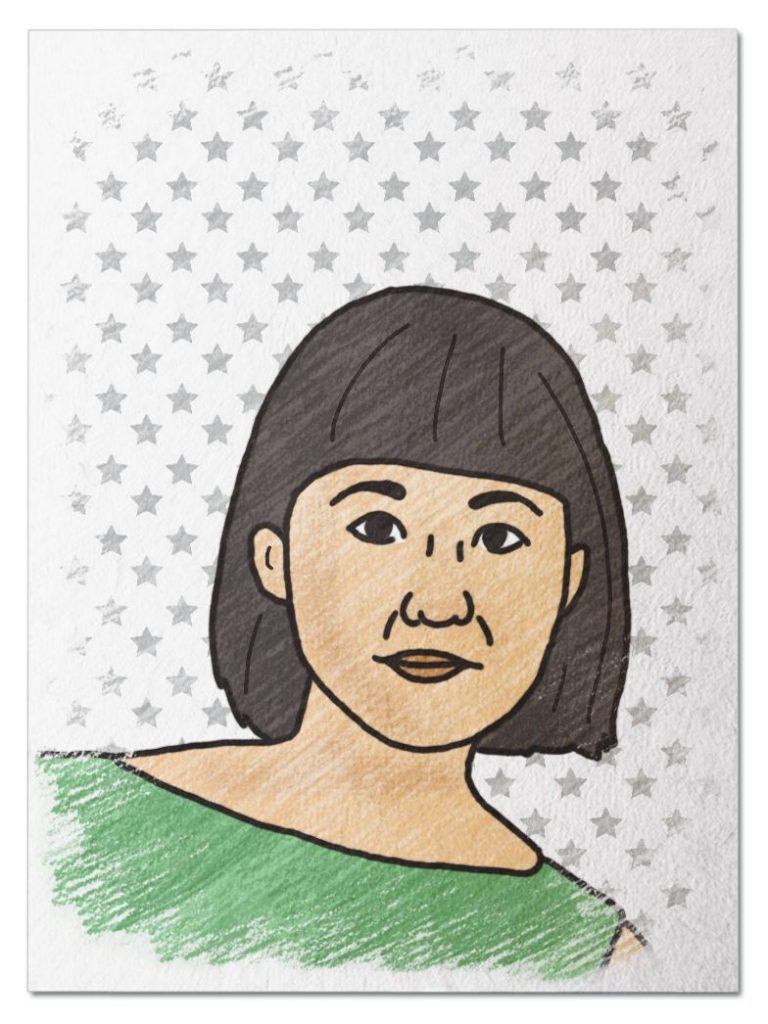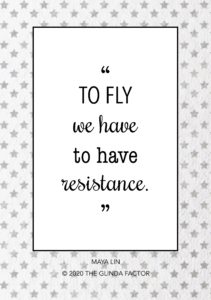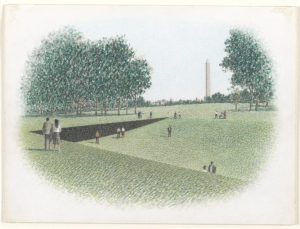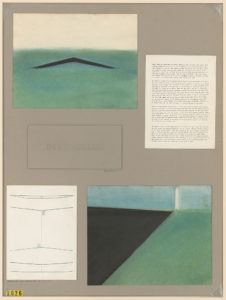
Amazing Artist
Her design for the Vietnam Veterans Memorial moves millions of visitors a year with its stark yet beautiful reminder of service and sacrifice. She found out she won the national design contest for the memorial a few days before her college graduation. Head to 1981 to meet 21 year old Maya Lin…
Her Ruby Shoe Moment
The Power of the Wand
Her Yellow Brick Road
Brains, Heart & Courage
Glinda’s Gallery
Just the Facts
Her Ruby Shoe Moment
Maya Lin heard a knock on the door of her dorm room at Yale University. In walked three officers of the Vietnam Veterans Memorial Fund. The men told her shocking news — she had won the national design competition for the new Vietnam Veterans Memorial. And their decision was unanimous. A 21-year old college student was chosen over some of the best architects in the country.
It was spring of 1981. After graduation, Maya moved to DC to oversee the details of the Memorial. A number of government agencies needed to approve the design, including the U.S. Commission of Fine Arts. As part of the process, the Commission held public hearings about the Memorial.
There was opposition to Maya’s design, especially from Vietnam veterans. Some people felt the Memorial wasn’t patriotic enough and didn’t adequately represent those veterans who survived the War. Others didn’t like the black granite, calling it a “gash of shame.” Maya sat in countless meetings to defend her design. Ultimately, she stood strong in two aspects of her design: the black granite and the chronological listing of names.
Veterans requested that the Memorial be constructed from white marble (which was more traditional). But Maya insisted on the black granite because it was integral to her design. She didn’t view black as a color, but simply as representing the earth. Maya said that her goal was to “open up the earth and polish the earth’s edges.” And the granite had to be so highly polished that people could see their reflection with the names — it would help them feel close to their loved ones.
 Some veterans asked that the prisoners of war be listed separately, while others suggested that the names be listed alphabetically. But Maya objected. She viewed the Memorial as a timeline of the War, where veterans could walk through the years and put their service in context. Maya also fought for the small font in her design (less than 1/2 inch). She wanted people to have an intimate experience — get close to the names and read them like a book.
Some veterans asked that the prisoners of war be listed separately, while others suggested that the names be listed alphabetically. But Maya objected. She viewed the Memorial as a timeline of the War, where veterans could walk through the years and put their service in context. Maya also fought for the small font in her design (less than 1/2 inch). She wanted people to have an intimate experience — get close to the names and read them like a book.
After over six months, Maya and the Commission finally reached a compromise. The black granite and chronological names would stay, but a new statue and American flag would be installed along the side of the Memorial. Detailed plans of the Memorial were formally approved on March 11, 1982. And Maya breathed a sigh of relief — she had successfully preserved the most important aspects of her design.
The Power of the Wand
All the controversy surrounding the Memorial dissipated after it opened. Maya’s design was a success — she created a place of healing for Vietnam veterans. Before long, it became a pilgrimage for thousands of people who lost family or friends in the Vietnam War. Today, the Memorial is one of the most visited sites along the National Mall.
The Memorial also changed how some Americans thought about war — it doesn’t glorify war but instead focuses on the individuals who served. In fact, some people consider it to be one of the most influential memorials in America. It also inspired the design of other memorials, such as the 9/11 Memorial.
Maya stayed true to her artistic vision for the Memorial and didn’t back down in the face of controversy. Her strength has inspired other women who share a message through their artistic designs — like Tatyana Fazlalizadeh. When she was 27 years old, Tatyana launched a poster campaign on the streets of Brooklyn called “Stop Telling Women to Smile.” It drew attention to the harassment that women are subject to in public spaces on a daily basis.
Her Yellow Brick Road
Maya’s design for the Memorial was a college assignment — it was the final project for her funeral architecture class. While doing her research, Maya studied a number of war memorials around the world. She realized that most of them either celebrated a victory or honored a leader. Maya decided she needed to create something different — a memorial that acknowledged the loss of life in war.
Her inspiration was the Yale University Memorial Rotunda, which contains the names of all alumni who died while serving in the military. She couldn’t resist touching the names when she passed it on campus. So she decided to focus on the power of a name, which has the ability to bring up countless memories of an individual.

Maya’s design come to her when she visited the proposed memorial site in DC. She envisioned a memorial that “cut” down into the earth — it was in harmony with the natural beauty of the park and would shield visitors from the noise of Constitution Avenue. The concept seemed too simple, but anything she added just felt like a distraction. So Maya followed her intuition.
Maya got a B on the project. Then, her professor encouraged her to submit the design to the national contest. She had never considered the idea, but decided to take a risk.
The Vietnam Veterans Memorial design competition was the largest of its kind in American history. There were over 1,400 entries — they had to be displayed in an airplane hangar at Andrews Air Force Base so the judges could view them all together.
The contest was judged by an eight member committee. And it was an anonymous process. An envelope on the back of each display contained the designer’s name.
Maya’s entry was a simple watercolor of her design. It consisted of two black granite walls that met each other in a “V” shape. Each wall was about 250 feet long and sank into the ground — the walls grew taller until they were 10 feet when they met at the “V.” The names of almost 58,000 men and women who died would be engraved on the walls in chronological order. She hand-wrote an explanation of her design on the display itself. Her idea was to create an “open wound” in the earth that symbolized the pain of losing loved ones during the Vietnam War.
The panel of judges loved Anonymous Entry #1026. One judge commented that it was “an eloquent place where the simple meeting of the earth, sky and remembered names contains messages for all.” You could imagine the judges’ surprise when they opened the envelope and saw her name — no one had ever heard of her before.
Immediately after it was announced that Maya won the contest, however, she began to experience discrimination and harassment. Some people criticized her for being a college student with no architectural experience. Others discriminated against her because of her race — they thought an Asian American should have no role in the memorial for a war against Southeast Asians.
Maya knew she had a long road ahead of her — the approval process for DC monuments was notoriously difficult — but she had no idea she was in for a battle. The whole process was so traumatic that Maya refused to talk about it for over 20 years. Looking back, Maya was convinced that she wouldn’t have won the contest if it hadn’t been anonymous. In some ways, she was amazed the Memorial was ever built.
Brains, Heart & Courage
Maya grew up surrounded by art. Both her parents worked for Ohio State University — her father was a ceramics professor and eventually became the Dean of Fine Arts; her mother was a professor of literature and loved to write poetry. Her older brother, Tan, was drawn to art as well (he became a poet, author and filmmaker).
While she was young, her parents stressed the importance of education, as well as the joy of being creative. Maya had a strong imagination and loved to build things — she particularly enjoyed creating miniature cities from paper. She also developed a passion for nature as a result of hiking in the woods and bird watching.
While in high school, Maya spent quite a bit of time on the Ohio State University campus — she took art classes, used her dad’s ceramics studio, and cast bronze sculptures at the college foundry.
Glinda’s Gallery
Visit Maya’s digital scrapbook on Pinterest: https://www.pinterest.com/theglindafactor/maya-lin/
Just the Facts
- Maya was born October 5, 1959 in Athens, Ohio. She has one brother.
- Maya is the daughter of Chinese immigrants. Both her parents left China right before the Communist Revolution (her father left in 1948 and her mother left in 1949). Their families had been part of the academic elite, but they knew life would change under the new regime. So they came to America in search of a new life.
- Maya earned both bachelor and master degrees in architecture from Yale University.
- In 1996, Maya married Daniel Wolf and they have two daughters.
- Maya is a successful architect and owns Maya Lin Studio, an architectural firm in New York City. She has designed everything from buildings to landscape to sculpture. And she is passionate about highlighting nature and the environment in her work.
- Maya has been involved in a number of other memorials throughout her career. She designed the Women’s Table at Yale University, which honors the role of women on campus.
- She also designed the Civil Rights Memorial in Montgomery, Alabama, which tells the story of the fight for civil rights and lists 40 people who died for the cause.
- Maya also served on the jury panel for the 9/11 Memorial design competition.
- The Vietnam Veterans Memorial received the 25-Year Award from the American Institute of Architects in 2007.
- Maya received the National Medal of Arts in 2009. In addition, she received the Presidential Medal of Freedom from President Obama in 2016. She also received honorary degrees from four colleges and was inducted into the National Women’s Hall of Fame.
Want to Know More?
Lin, Maya. Boundaries. New York: Simon & Schuster, 2006.
Lin, Maya. “Making the Memorial.” The New York Review of Books, November 2, 2000.
Reston, James. A Rift in the Earth: Art, Memory, and the Fight for a Vietnam War Memorial. New York: Simon & Schuster, 2017.
Academy of Achievement (http://www.achievement.org/achiever/maya-lin/)
Maya Lin Studio (http://www.mayalin.com)


